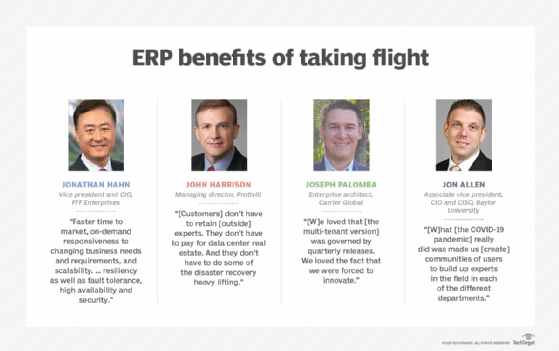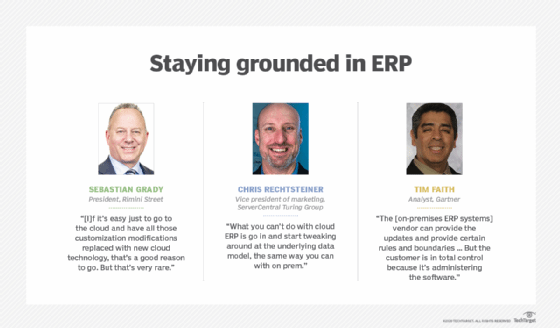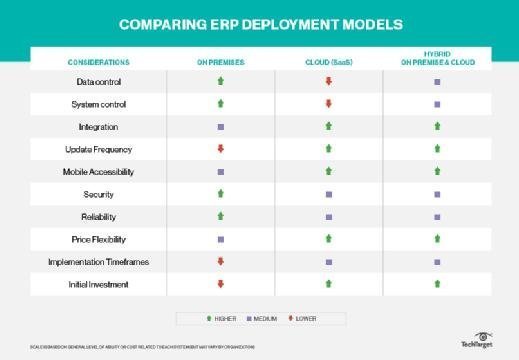Cloud ERP implementation answers need for speed and agility
As demand accelerates for greater speed, flexibility and efficiency in collecting, managing and analyzing corporatewide data, ERP migration to the cloud is paying dividends.
After years of running an Infor M3 ERP system on premises, FFF Enterprises Inc. decided to implement SAP S/4HANA ERP in the cloud and now has a three-year track record to talk about.
A pharmaceutical distribution company based in Temecula, Calif., FFF Enterprises opted for the cloud ERP implementation in 2017 partly to free up its IT team to focus on innovation and support, according to vice president and CIO Jonathan Hahn. "We really wanted to adopt cloud just so that it provides us with other benefits [as well], such as our ability to be faster and more agile," he said. "Faster time to market, on-demand responsiveness to changing business needs and requirements, and scalability. Another important thing is resiliency as well as fault tolerance, high availability and security."
Initially, the company selected Virtustream to host its S/4HANA system. But after experiencing some server-related issues, FFF Enterprises moved its SAP workloads to Google Cloud in 2019. The move, Hahn noted, helped his company overcome the challenges of SAP hosting infrastructure outages and downtime.
Cloud ERP comes in 3 flavors
Cloud ERP software runs on a provider's cloud computing platform, rather than on premises in a company's own data center. Here's a look at the various types of cloud ERP implementation options:
- Multi-tenant software as a service (SaaS). A single instance of the software and its supporting information serves multiple customers. Each customer shares the software application as well as a single database, but each tenant's data and ERP system is isolated and remains invisible to other tenants. Multi-tenant architecture enables the exchange of services, databases, resources and applications, so it can cost less than a single-tenant structure.
- Single-tenant SaaS. Each user has a dedicated server and supporting infrastructure. Single-tenant products can't be shared among customers. A customer's data and ERP system are cordoned off from other customers' systems. Users can customize the software according to their requirements. Each type of SaaS ERP is usually hosted on a third-party public cloud, such as AWS, Google Cloud and Microsoft Azure.
- Private cloud. An organization using a private cloud setup doesn't share resources with other users because it's a single-tenant environment. A private ERP cloud can even run entirely on premises in companies that build their own cloud infrastructures or on infrastructures provided by third parties. In some cases, the ERP owner has some control over IT decisions instead of delegating them all to the hosting provider.
Some companies may opt for a hybrid cloud ERP implementation. A typical setup retains on-premises ERP -- perhaps a system that's highly customized and closely integrated with other on-premises systems for manufacturing and warehouse management -- and adds specialized SaaS ERP modules for human capital management or customer relationship management.

Cloud vs. on-premises ERP
Cloud ERP software is priced according to a monthly or annual subscription, with additional recurring fees for support, training and updates. Companies just pay for the resources they use. As needs change, cloud ERP users have the flexibility to add or subtract cloud resources. An additional ongoing overhead cost, cloud-based ERP is considered an operating expenditure.
On-premises ERP software is priced under a one-time perpetual license fee, usually based on the size of the company or the number of concurrent users. Even though there are recurring fees for support, training and updates, an on-premises ERP system is considered a capital expenditure because it's basically one large upfront investment.
In general, it's easier to modify on-premises ERP systems, said Chris Rechtsteiner, vice president of marketing at IT infrastructure provider ServerCentral Turing Group. "If it's on prem, you can customize 100% of it, all the way down to the data schema," he said. "You can literally go into SAP or Oracle or any of those [on-premises] ERP systems, and if you have developers, you can just start tinkering at the data level and change what it's going to do."
The process is different when customizing cloud ERP systems. "What you can't do with cloud ERP is go in and start tweaking around at the underlying data model, the same way you can with on prem," Rechtsteiner explained. "But in terms of customization, you can do anything you want to do. … [T]hose customizations happen a little bit higher level in the application stack."
Another difference between on-premises and cloud ERP is the degree of user control, Gartner analyst Tim Faith said. "Because the customer's running [on-premises ERP] in its data center, the customer has much more control," he explained. "The vendor can provide the updates and provide certain rules and boundaries of when these updates need to be applied. But the customer is in total control because it's administering the software."
But as companies transform and get leaner and smarter, they tend to implement cloud-based products so IT can focus on more strategic decision-making and "less clicks," according to John Harrison, managing director at consultancy Protiviti. "The other benefit is really just a more broad cloud benefit, which is it's someone else's [the vendor's] problem in terms of the hardware, in terms of the software maintenance," Harrison said. "[Customers] don't have to retain those experts. They don't have to pay for data center real estate. And they don't have to do some of the disaster recovery heavy lifting."

Choosing the right time for a cloud ERP implementation
A company might choose to move its on-premises ERP system to the cloud when its business or the industry is undergoing major changes. "That's a good time to start looking at some of the offerings that the cloud could bring to you," Harrison said. "What we're seeing with our client base is that this wave of business transformations and digital transformations really are forcing companies to ask what they want to look like in the next five years. And as they look at the different options out there, they lean heavily toward some sort of cloud aspect."
Companies should look at the customizations they've made over the last 10 or 15 years in on-premises products, suggested Sebastian Grady, president of third-party software support services provider Rimini Street. Some of them are very necessary to run their businesses, while others may be unnecessary and might acquire what he called "technical debt."
"So, if you have a ton of technical debt," he added, "and it's easy just to go to the cloud and have all those customization modifications replaced with new cloud technology, that's a good reason to go. But that's very rare. It's a very hard business case to find."
Carrier Global Corp., an HVAC company based in Palm Beach Gardens, Fla., was in the process of digitally transforming its sales and service processes and needed to replace an old on-premises system running antiquated applications. The company went live last January on the SAP S/4HANA Cloud Essentials ERP system, formerly called the Multi-Tenant Edition.
"We moved from a 40-year-old mainframe AS/400 system," said Carrier Global enterprise architect Joseph Palomba. "It was a cobbled together costing system that we used to cost the service business, and it connected to many other disparate custom-built applications -- call it the business process -- that formed the service business. We selected the multi-tenant version for a host of reasons. Financially, it was a heck of a lot cheaper [than the single-tenant version]. And we loved that it was governed by quarterly releases. We loved the fact that we were forced to innovate. . . . [I]t was the fit to the standard approach that protected us from ourselves."

The COVID-19 effect
Some companies that had started the migration process from on-premises to a cloud ERP implementation put their plans on hold or are migrating at a slower pace as a result of the disruption caused by the COVID-19 pandemic, Harrison noted.
Nova Services, a diversified oil and gas field services company based in Hobbs, N.M., needed to gather as much information as possible in one location so the CFO and his team could make better business decisions. The company moved from its SAP Business One on-premises ERP and went live on an SAP Business ByDesign cloud ERP system last August.
"We have multiple companies under the one umbrella, and ByDesign has a much better intercompany-type of structure where we can report income statements for different companies on one income statement," said Nova CFO Gerald Bromley. "[The cloud] makes it easier with the pandemic -- but even before that, because people can work from anywhere in the world as long as they have some internet connection."
Baylor University in Waco, Texas, decided to replace its on-premises PeopleSoft Financials system with the Oracle Cloud ERP. The university also opted to replace its manual processes with Oracle Cloud Enterprise Performance Management and Oracle Cloud HCM to connect departmental silos, standardize processes, and manage financial, planning and workforce data on one integrated cloud platform, said Jon Allen, Baylor's associate vice president, CIO and CISO.
The project kicked off in August 2018 and went live last month. "I think if anybody's experienced one of these large systems go-lives," Allen said, "there's the whole concept of war rooms and everybody looking at whiteboards and data and communicating at round tables."
But all that planning was disrupted by COVID-19. Allen and his team had to determine how to replicate those scenarios in a virtual world. Collaboration was key, he said, and Microsoft Teams played a role in planning, communication and closely tracking issues.
Training also was critical. "[Before the pandemic], we had online training when you got into the larger user groups," said Allen. "But what [the pandemic] really did was made us [create] communities of users to build up experts in the field in each of the different departments so that there were virtual resources always available."
Allen and his team even created a chatbot in Microsoft Teams where people could ask questions specifically around the platform. They also implemented Oracle Guided Learning to help users get up to speed on the cloud applications -- something Allen hadn't planned to deploy before COVID-19.
"But we wanted to make sure that those resources were at the fingertips of the users who needed them, who maybe didn't get the same level of handholding that they would have received traditionally in a classroom," Allen explained. "And we found that the tool allowed us to be super dynamic in the messaging to our users as they were becoming familiar with the platform."






